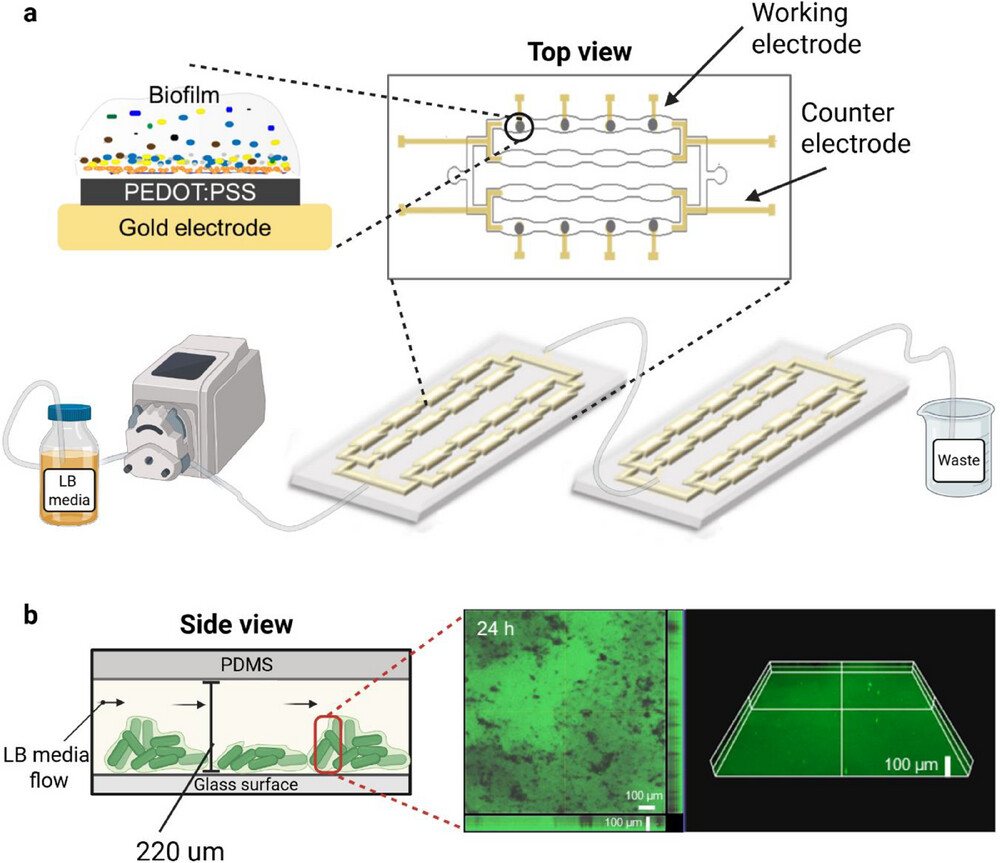
26 Sep A Modular Microfluidic Platform for Real-Time Biofilm Analysis
Biofilms, dense microbial communities on medical devices and tissues, are notoriously resistant to antibiotics, causing persistent infections that account for many of chronic cases. Traditional lab methods often miss key aspects of biofilm behavior, including persistence, regrowth, and migration, making it difficult to design effective treatments.
Researchers developed a modular, Lego-like microfluidic chip that allows continuous, real-time monitoring of biofilm growth, antibiotic response, and recolonization. The microfluidic device integrates both optical microscopy and electrical impedance spectroscopy, offering multimodal and label-free insights into biofilm dynamics under physiologically relevant conditions.
“A modular microfluidic platform with integrated electrodes is presented for dynamic sampling and monitoring of biofilm formation and response. Its architecture enables natural shear stress variations and allows label-free studies, including optical microscopy and electrical impedance spectroscopy.”

“Biofilm on chip design. a) experimental setup of the two microfluidic chips connected ins Lego-like structure to study different conditions of biofilm, including biofilm formation in the first chip and biofilm migration to the second chip. Additionally, the top view of the first chip shows the integrated electrode system that allows the real time, non-disruptive, and label-free detection of biofilm through EIS. b) Schematic representation of biofilm formation as viewed from the side of the chip, and the 100 µm thickness of 24h formed biofilm as imaged via confocal microscope and represented by 3D configuration. The biofilm was stained with FilmTracer SYPRO™ Ruby biofilm matrix stain. The figure is created in https://BioRender.com.” Reproduced from , , , , , , , , , , A Modular, Lego-Like Microfluidic Platform for Multimodal Analysis of Biofilm Formation and Antimicrobial Response. Adv. Mater. Interfaces 2025, e00303. under Attribution 4.0 International License.
The platform was microfabricated from PDMS using photolithography and designed with wavy microchannels (220 μm) that mimic natural flow conditions, such as those found in catheters. These channels created low-shear microenvironments that promoted realistic biofilm development.
- Integrated electrodes coated with PEDOT:PSS enabled sensitive, non-disruptive electrical readouts.
- Multiple microfluidic chips could be connected in a Lego-like manner, allowing sequential studies of migration and regrowth.
- Experiments used Pseudomonas aeruginosa biofilms, a clinically relevant model, under controlled flow at 30 μL/min.
The microfluidic platform successfully captured biofilm progression from initial adhesion to maturation and dispersion. When treated with antibiotics, tetracycline, chloramphenicol, and amikacin, the microfluidic device revealed distinct survival strategies: bacteriostatic drugs halted growth but did not clear biofilms, while amikacin reduced biomass but allowed regrowth.
In addition, coating the microfluidic chip with green-synthesized silver nanoparticles prevented biofilm establishment, pointing to a preventive strategy for biofilm control. Using connected fluidic modules, the researchers further demonstrated how treated biofilms could migrate and recolonize new sites once antibiotic pressure was removed, an important clinical concern.
Real-time impedance measurements confirmed these trends, providing a non-invasive way to track biofilm formation, treatment, and regrowth.
This modular microfluidic platform offers a versatile and biologically relevant system for studying biofilm resilience. Its ability to evaluate treatments, coatings, and regrowth under realistic conditions makes it a promising tool for antimicrobial screening and early-stage therapeutic development. With its simple, scalable design, the platform could also be adapted for clinical decision-making to guide patient-specific treatments.
“This platform can be readily applied in fundamental biofilm research, antimicrobial screening, and early-stage drug discovery. Its portability, enabled by the use of low-cost materials and a simple, scalable, compact setup, further supports its practical potential outside conventional laboratory settings. For broader translation into clinical use, further improvements such as automation and integration with user-friendly data acquisition tools will be needed..”, the authors concluded.
Figures are reproduced from D. Islayem, S. Arya, N. Yasmeen, N. Hallfors, H. Ngoc, S. Alkhatib, I. Mela, S. Anwar, V. K. Truong, A. M. Pappa, A Modular, Lego-Like Microfluidic Platform for Multimodal Analysis of Biofilm Formation and Antimicrobial Response. Adv. Mater. Interfaces 2025, e00303. https://doi.org/10.1002/admi.202500303 under Creative Commons Attribution 4.0 International License.
Read the original article: A Modular, Lego-Like Microfluidic Platform for Multimodal Analysis of Biofilm Formation and Antimicrobial Response
For more insights into the world of microfluidics and its burgeoning applications in biomedical research, stay tuned to our blog and explore the limitless possibilities that this technology unfolds. If you need high quality microfluidics chip for your experiments, do not hesitate to contact us.


